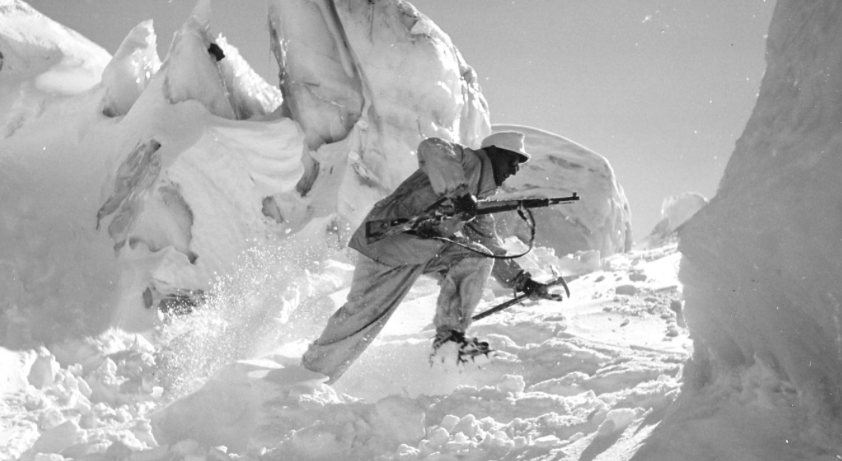The Gewehr 1871 was the first rifle adopted by the newly-formed German state after its unification at the end of the Franco-Prussian War. It replaced the decades-old Dreyse needle rifles, and fired an 11x60mm black powder cartridge. It was the first significant rifle designed by the Mauser brothers, and would evolve into the iconic and ubiquitous Mauser 98 design over the years.
Related Articles

RIA: G33/40 Gebirgstruppen Carbine
The G33/40 carbine was made by the excellent Czech factory at Brno under German occupation (between 1940 and 1942). It was essentially a copy of the Czech vz.33 carbine, and was specifically issued to the […]

So Many Machine Guns!
Not too long ago, a pretty serious machine gun collector named Richard Wray passed away, and his estate is auctioning off his collection, which includes 80-odd transferable machine guns – nearly all of them very […]

Book Review: ERMA Erfurter Maschinenfabrik 1924–2003 (Three Volumes)
Available from Schiffer Publishing as three separate volumes: https://www.schiffermilitary.com/collections/military-new-releases/products/erma-erfurter-maschinenfabrik-1924-2003-vol-1 https://www.schiffermilitary.com/collections/military-new-releases/products/erma-erfurter-maschinenfabrik-1924-2003-vol-2 https://www.schiffermilitary.com/collections/military-new-releases/products/erma-erfurter-maschinenfabrik-1924-2003-vol-3 Hot off the presses from Schiffer Publishing, we are looking at Holger Schlemeier’s expanded English version of “ERMA: Erfurter Maschinenfabrik, 1924–2003”. This is a […]

Jawohl Johann, das its eine ausgezeichnet presentation…danke sehr!
Getting creative, huh? That rifle is robust looking; probably quite hefty. How much does it weight?
Should be, I think, “eine ausgezeichnete Präsentation” 😉
Oh, you are right. I am just picking what is left after being pounded with English only for many years.
Great look, Ian!
Der Pickelhaube is you!
Nice pickelhaube, Ian! The first Mauser rifles were rather crude by today’s standards but if I recall correctly, they actually cocked the striker during the bolt stroke without the user being required to yank the cocking piece by hand first.
Yep, that is correct.
You can be such a goof Ian! Love it! Also, thank you for another informative video.
Interesting to see an early Mauser action…so familiar but also so “crude” compared to the later refinements.
113. Reserve Regiment Company 5 Rifle 7. And the markings are acceptance stamps, not proof marks.
The “115.R” would indicate 115th Reservieren (Reserve) infantry. The “5.T” would be 5th Truppe (troop).
A script capital “R” would indicate a Reiter(cavalry)unit, which would be a very unlikely marking to find on the full-length infantry rifle as opposed to a carbine.
BTW, the Mauser round is properly the 11.15 x 60R. It is similar to such rounds as the 11.15 x 58R Spanish Remington (used in rolling blocks, aka “.43 Spanish”), the 11.15 x 58R Werndl, the 11 x 59R Gras, and the 11 x 60R Japanese Murata.
During the Philippine Insurrection
(1899-1912), any or all of the above were used interchangeably by the Moros and etc. in Remington Rolling Blocks, Mausers, Muratas, and about anything else that could theoretically chamber and fire them. They are NOT considered “interchangeable”, but resistance fighters and guerrillas are noted for not paying much attention to such things. Or to operator safety.
Cartridge collectors still occasionally encounter “improvised” rounds in these calibers, made from copper tubing brazed to copper discs, rolled copper sheet brazed into a tube and formed, etc., plus rounds that have been reloaded “in the field” with improvised black powder and re-manufactured primers (match head composition used for priming).
If you run across an 11.15 x 60R loaded with the jacketed bullet of the Spanish 11.5 x 57R “Reformado” cartridge, you’re very likely looking at a Filipino “reload”.
The best article I’ve seen on this is one by Graham Burnside, on pp. 36-27 of the August 1959 issue of Guns & Ammo magazine which I happen to have. I believe this is a long-neglected area of cartridge and military small-arms research that deserves a second look.
cheers
eon
This 11.15mm, would it be actual ball diameter or is it bore size as in European tradition? In that case actual shot would be slightly bigger…
“11.15mm”
http://www.municion.org/11_15x60R/11_15x60R.htm states that bullet diameter is 11,32mm so 11,15mm refer to bore diameter.
This shot would have been suitable for tubular magazine; it has flat tip. Also of interest is a ‘mini-shoulder’ which suggests that head-spacing was not on rim.
Overall, pretty good looking cartridge for its time.
“it has flat tip”
Spitzer bullet was invented (or at least entering common military service) in 1890s-1900s; all earlier cartridge has round-nose or flat-nose bullets, so can be adopted for tubular magazine.
“suggests that head-spacing was not on rim”
For me choice of “headspace on shoulder” instead of “headspace on rim” (if rim is present) looks not logical, first require more tight tolerances, second will allow more loose tolerances.
I’m not sure but does not ALL rimmed cartridges headspace on rim?
“pretty good looking cartridge for its time.”
Notice the base, IIRC it was designed in that way so extractor claw can easier catch rim, than in flat-base cartridges
Besides being the start of the Mauser rifles, this gun was also the beginning of the Mannlicher turn-bolt rifles. Many of the features seen here are even more recognizable in the Mannlichers. Great video, keep them coming!
Interesting bolt and barrel band/retainer pins. You could have posted the lot number for the helmet in the description. Nice touch with the mustache wax.
Ian, you are forgetting to mention that the Mauser brothers added the middle stop on that paddle safety. The rifle won’t go BOOM! if you can’t see what you are aiming at.
Ian, What brand of moustache wax do you use?
It was borrowed – I don’t recall the brand.
” moustache wax”
If you are interested in it, see also:
http://weird-vintage.com/post/92082639664/the-kaiser-mustache-trainer-will-overcome-every
Ian,
Was that the Fire brigade officer’s helmet?
http://www.rockislandauction.com/viewitem/aid/1026/lid/2748
I saw this on youtube and I inherited a model 71 so it peaked my interest. mine doesn’t have any of the four manufacturers stamped on the receiver that you metioned.it is still in its single shot configuration , hasn’t been converted to 71/84 it is dated 1878 and is stamped GEBR MAUSER&CO OBERNDORF. is oberndorf any rarer than Erfurt, amburg, danzig or Spandau?
I have a Steyr made IG71 as well (dated 1874) – any idea why Germany had to pursue foreign contracts for their rifles?
Hello Ian
I liked the german. Realy not to bad. The Bawariens had there one Rifle 1871. Do there keep it? Will there be a feature about the Werder Gewehr M/1869 some time? Also a new feature about the Awtomat Fjodorowa would be nice.
Stephan
Or about Werndl? Andrzej
Ian, when you say the screws were “proofed,” do you mean that there was some mechanical stress applied to them that they must have withstood in order to be accepted? Or does the serialization of those screws mean that they were somewhat unique, and thus not interchangeable with other screws? The one you pointed out only had the last 2 digits of the serial number.
I’ve got a pdf of the manual for this dated 1878. let me know if you want a copy
I would!
https://www.dropbox.com/s/w4f4scywl1vfon9/Mauser%2071.pdf?dl=0
MAUSER 71 MANUAL PDF
Thanks!
I have a nice, full set of blueprints for this and the Karabiner 71, and there are some interesting things to note, Ian.
First off, the rifle in the video has a broken bolt retaining screw, as it should not be able to fully come out at all. There is a pin (present on the rifle in the video) which should retain the screw and allow it to come out only far enough to remove the bolt.
Second, an interesting design choice is that the rear 3mm of the locking rib on the bolt for the Gewehr 71 is a separate piece which is pinned (and then possibly brazed?) in place. However, this feature was removed from the bolt for the Karabiner 71, which has the same overall shape but is of one-piece construction. I am unsure why they decided to go with that design, but I can guess either so the bearing surface could be made of harder, better steel, or because it was a wear point and they wanted to be able to replace it as it wore down.
To illustrate, here is a rendering of the rifle bolt in a partial cross-section: http://i.imgur.com/C4bB2D6.png
And this is the same, but for the carbine bolt: http://i.imgur.com/UyMmDGB.png